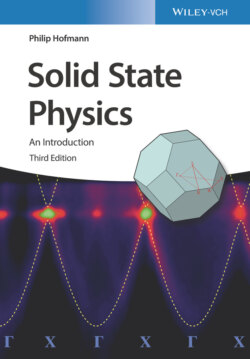Читать книгу Solid State Physics - Philip Hofmann - Страница 25
1.3.1.5 The Meaning of the Reciprocal Lattice
ОглавлениеWe have now defined the reciprocal lattice in a proper way, and we will give some simple examples of its usefulness. The most important feature of the reciprocal lattice is that it facilitates the description of functions with the same periodicity as that of the lattice. To see this, consider a one‐dimensional lattice, a chain of points with a lattice constant (Fig. 1.11). We are interested in a function with the periodicity of the lattice, such as the electron concentration along the chain, . We can write this as a Fourier series of the form
(1.19)
with real coefficients and . The sum starts at , the constant is therefore outside the summation. Using complex coefficients , we can also write this in the more compact form
(1.20)
To ensure that is still a real function, we require that
(1.21)
that is, that the coefficient must be the complex conjugate of the coefficient . This description is more elegant than the one with the sine and cosine functions. How is it related to the reciprocal lattice? In one dimension, the reciprocal lattice of a chain of points with lattice constant is also a chain of points, now with spacing [see Eq. (1.17)]. This means that we can write a general reciprocal lattice “vector” as
(1.22)
where is an integer. Exactly these reciprocal lattice “vectors” appear in Eq. (1.20). In fact, Eq. (1.20) is a sum of functions with a periodicity corresponding to the lattice vector, weighted by the coefficients . Figure 1.11 illustrates these ideas by showing the lattice and reciprocal lattice for such a chain as well as two lattice‐periodic functions, both in real space and as Fourier coefficients on the reciprocal lattice points. The advantage of describing these functions by the coefficients is immediately obvious: Instead of giving for every point in a range of , the Fourier description consists of just three numbers for the upper function and five numbers for the lower function. Actually, these even reduce to two and three numbers, respectively, because of Eq. (1.21).
Figure 1.11 Top: A chain with a lattice constant as well as its reciprocal lattice, a chain with a spacing of . Middle and bottom: Two lattice‐periodic functions in real space as well as their Fourier coefficients. The magnitude of the Fourier coefficients is plotted on the reciprocal lattice vectors they belong to.
The same ideas also work in three dimensions. In fact, one can use a Fourier sum for lattice‐periodic properties that corresponds to Eq. (1.20). For the lattice‐periodic electron concentration , we get
(1.23)
where are the reciprocal lattice vectors.
Thus we have seen that the reciprocal lattice is very useful for describing lattice‐periodic functions. But this is not the whole story: The reciprocal lattice can also simplify the treatment of waves in crystals in a very general sense. Such waves can be X‐rays, elastic lattice distortions, or even electronic wave functions. We will come back to this point at a later stage.
